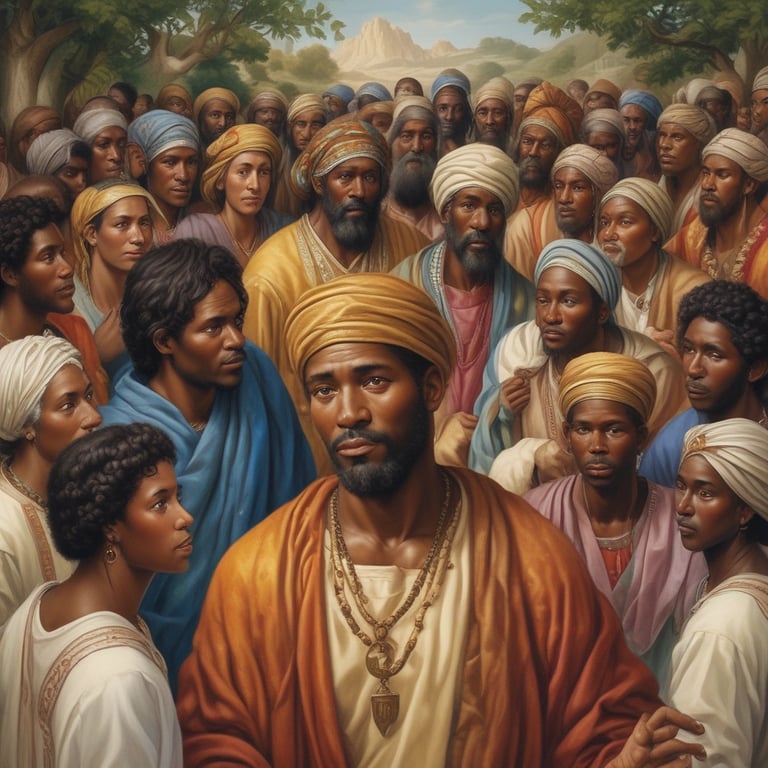Blacks and Other People of Color in the Bible
Revolutionizing Bible Stories: Why Representation Matters for Children of Color: Imagine a child sitting down to read a Bible story, eager to learn about the heroes and lessons within its pages. Now, picture that child searching for someone who looks like them, only to find a sea of characters that do not reflect their own identity. The lack of representation in traditional Bible stories for children of color not only limits their connection to these narratives but also perpetuates a narrow view of the world. It's time to revolutionize the way we tell these stories and prioritize diversity in the pages of scripture. In this article, we will explore the impact of representation in children's literature, the challenges faced by children of color in traditional Bible stories, the importance of including diverse characters in biblical narratives, and practical ways to make these stories more inclusive. By embracing diversity in our storytelling, we can create a more inclusive and empathetic learning experience for all children.
UNLOCK THE POWER: TRANSFORMING MINDS AND HEARTS OF ALL AGES
Arthur Comer
12/15/20244 min read


The Impact of Representation in Children's Literature
Representation in children's literature plays a crucial role in shaping the way young readers view themselves and the world around them. When children see characters who look like them in stories, it validates their experiences and fosters a sense of belonging. It also exposes them to different cultures, perspectives, and ways of life, promoting empathy and understanding. By including diverse characters in children's literature, we not only provide more accurate reflections of society but also open up new possibilities for learning and growth. This emphasis on representation is especially important when it comes to Bible stories, as they serve as foundational narratives for many children's spiritual and moral development.
Challenges of Traditional Bible Stories for Children of Color
Traditional Bible stories often present challenges for children of color due to the lack of representation and diversity within the narratives. Many classic Bible stories feature predominantly white characters in European settings, which can make it difficult for children of color to see themselves reflected in these stories. This lack of representation can lead to feelings of alienation, disconnection, and even inferiority for children who do not see people who look like them represented in the stories they are told. Additionally, the absence of diverse characters in traditional Bible stories can perpetuate harmful stereotypes and reinforce the idea that only certain groups of people are worthy of being included in spiritual narratives.
Furthermore, traditional Bible stories often fail to address the experiences and struggles faced by people of color, which can limit their ability to connect with and relate to the stories being told. Without representation of diverse characters and perspectives, children of color may struggle to find relevance and meaning in these stories, ultimately missing out on the valuable lessons and teachings that they have to offer. As such, the lack of diversity in traditional Bible stories can undermine the spiritual and moral development of children of color, hindering their ability to fully engage with and benefit from these important narratives.
Despite these challenges, there is a growing recognition of the importance of including diverse characters in biblical narratives to better reflect the diversity of the world and to ensure that all children feel seen, valued, and included in the stories that shape their understanding of faith and morality.
Benefits of Including Diverse Characters in Biblical Narratives
Including diverse characters in biblical narratives not only helps children of color see themselves reflected in the stories but also creates a more inclusive and welcoming space for all readers. By incorporating characters from different ethnicities and backgrounds, Bible stories can become more relatable and relevant to a wider audience, fostering a deeper understanding and appreciation of the lessons and teachings within. This shift towards representation allows children to connect with these narratives on a personal level, opening up opportunities for growth, empathy, and cultural awareness.
This focus on diversity in biblical storytelling sets the stage for practical ways to incorporate representation in Bible stories, ensuring that children of all backgrounds can feel connected to the timeless messages and wisdom found within these narratives.
Practical Ways to Incorporate Representation in Bible Stories
One key way to incorporate representation in Bible stories is by using resources and materials that feature diverse characters. Look for children's Bibles, storybooks, or educational materials that include individuals from various backgrounds and cultures. This simple step can help children of color see themselves reflected in the stories they read and engage with.
Another practical way to promote representation is by incorporating art and visuals that showcase diversity. Choose illustrations and pictures that depict characters from different ethnicities and races to provide a more inclusive and accurate portrayal of biblical narratives. By visually representing diverse individuals, children can better connect with and relate to the stories they are exploring.
Additionally, consider discussing and exploring different cultural interpretations and perspectives of Bible stories. Encourage open conversations about how various communities and traditions understand and apply these narratives in their lives. By acknowledging and embracing different viewpoints, children can gain a broader understanding of the richness and depth of these timeless teachings.
By taking these practical steps to incorporate representation in Bible stories, we can create a more inclusive and empowering environment for children of all backgrounds. This intentional focus on diversity helps to ensure that everyone can find themselves reflected in these narratives, fostering a sense of connection, empathy, and cultural appreciation in young readers.
In a world where representation matters more than ever, the importance of inclusive and diverse characters in Bible stories cannot be overstated. By embracing the power of representation, we can reshape the way children of color see themselves in the narratives of scripture and foster a more empathetic and inclusive learning environment. Let us take up the challenge to revolutionize the way we tell these stories, ensuring that all children see themselves reflected in the pages of the Bible. As we strive towards a more diverse and inclusive future, let us remember the words of Maya Angelou, "We all should know that diversity makes for a rich tapestry, and we must understand that all the threads of the tapestry are equal in value no matter their color."
Click here to view the above introduction to my ever-growing collection of audiobooks, ebooks, animated videos, and coloring books designed to combine a fun listening and reading experience with valuable life lessons.
This collection is FREE to Download and is tailored to cater to the innate
curiosity of growing minds.
Click Here to visit the FREE Download site!
Jewelry of Distinction
Subscribe Today!
Central Virginia Cactus Growers Society
Email: arthur@alcjr.com
© 2025. All rights reserved.


ALCJR Enterprises
Affiliate Marketing Disclosure Statement
At ALCJR Enterprises, transparency and trust with my audience are paramount. By the Federal Trade Commission's guidelines, I want to ensure that you, my valued visitors, fully understand my relationship with the products and services I feature.
My Affiliate Relationships with Amazon and Other
Some of the links on my website are affiliate links, which means that if you click on the link and make a purchase, I may receive a commission at no additional cost to you. These commissions help support my website and allow me to continue providing valuable content. Please note that my opinions are my own, and I only recommend products or services I truly believe will bring value to my audience.
Why I Use Affiliate Links
Support My Work: The commissions earned through affiliate links help me maintain the quality and integrity of my content.
No Additional Cost: The price you pay as a customer is not affected by my affiliate partnerships.
Commitment to Quality: I am committed to recommending products that I have either used myself or thoroughly researched.
My Promise to You
I am dedicated to maintaining the trust of my audience. That's why:
I will always disclose my affiliate relationships clearly and openly.
I will provide honest reviews and insights, regardless of any affiliate partnerships.
I will prioritize your interests and ensure that my content remains unbiased and reliable.
Thank you for supporting ALCJR Enterprises. Your trust means everything to me. If you have any questions about my affiliate relationships, please feel free to contact me at alcjr@verizon.net.
